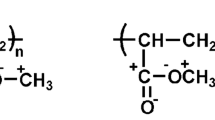Conclusions
In the present paper a large amount of data is presented and discussed, which however is not yet sufficient to allow a clear solution to be drawn to the problem, which is:
-
i)
how do the structural parameters of a given fluorinated acrylic polymer correlate with the material properties and the protective effectiveness of the coatings made therefrom, and
-
ii)
what are the key factors that need to be thoroughly understood in order to be able to adapt the macromolecular structure and/or the coating formulation, so as to achieve the effective protection of chemically diverse and morphologically complex stone surfaces of different natures, for a durable and esthetically acceptable material.
Whilst, on one side, the results obtained show clearly the promising properties of the polymers under investigation as protective materials for stoneworks, they are still far from establishing a well defined relationship that could make it possible to define the optimal structural features to fulfil all the requirements of such applications. Indeed the testing reported in this work has not allowed to clearly discriminate between materials differing in fluorine content and distribution, particularly in terms of the differences that one can expect when testing these materials on different lithotypes.
Nevertheless, the results obtained provide a great deal of information regarding the effect that the content and distribution of fluorine in the acrylic polymers exerts on such chemical and physical properties of the resulting material as its glass transition temperature and its thermal, chemical and photochemical stability.
Further studies are necessary before these materials be considered for use as new and durable coatings for the protection of stonework. In particular, it is necessary to have a better understanding of the possible role that the various structural features of these polymers have in modifying and improving the significant properties of their coatings, such as condensed water repellency, permeability to water vapour and adhesion to the substrate.
This work was partially supported by CNR-Rome Target Project for conservation of monumental buildings.
Similar content being viewed by others
References
Chiantore O, Lazzari M,Int. J. Polym. Analysis & Characterization,2, 395, 1996.
Botteghi C, Matteoli U, Paganelli S, Arbizzani R, Ciardelli F, Aglietto M, Taburoni E, and Fassina V,Sci. & Technol. Cultural Heritage,1, 111, 1992.
Ciardelli F, Aglietto M, Passaglia E, Montagnini di Mirabello L, and Ruggeri G,Paints and Varnishes,72 (3), 21, 1996.
Brady R F,Chemistry in Britain, 427, 1990;
Zhang Y-X, Da A-H, Butler GB, and Hogen-Esch TE,J. Polym. Sci., Part A: Polym. Chem.,30, 1383, 1992.
Höpken J, Shieko S, Czech J and Möller M,ACS Polym. Prepr.,33 (1), 937, 1992.
Boutevin B, Ameduri B,Macromol. Symp.,82, 1, 1994.
Aglietto M, Passaglia E, Taburoni E, Ciardelli F, Botteghi C, Matteoli U, Paganelli S, Arbizzani R and Fassina V, ‘ICOM Committee for Conservation’, Vol.II, 553–558, 1993.
Fassina V, Arbizzani R, Botteghi C, Matteoli U, Passaglia E and Aglietto M, ‘III Int. Symposium on the Conservation of Monuments in the Mediterranean Basin’, 22–25 June 1994, Venice, Italy, Proceedings, 911–918, 1994.
Matteoli U, Aglietto M, Fassina V, Botteghi C, Passaglia E and Ciardelli F, ‘Int. Colloquium on Methods of evaluating products for the Conservation of porous building materials in monuments’, 19–21 June 1995, Rome, Italy, Abstracts, 373, 1995.
Aglietto M, Passaglia E, Montagnini di Mirabello L, Botteghi C, Paganelli S, Matteoli U and Menchi G,Macromol. Chem. Phys.,196, 2843, 1995.
Botteghi C, Matteoli U, Paganelli S, Arbizzani R, Ciardelli F, Aglietto M, Taburoni E and Fassina V,JANUACHEM 92 (Italian Chemical Society National Conference), Proceedings, 949, 1992.
Chiantore O, Lazzari M, Aglietto M and Montagnini di Mirabello L, ‘1st International Congress on Science and Technology for the Safeguard of Cultural Heritage in the Mediterranean Basin’, Catania, Italy, Abstracts, December 1995.
‘Contact angle measurement’. NORMAL Recommendation 33/89, CNR-ICR, Roma, 1991.
Author information
Authors and Affiliations
Rights and permissions
About this article
Cite this article
Castelvetro, V., Aglietto, M., Montagnini di Mirabello, L. et al. Adapting the properties of new fluorinated acrylic polymers to suit the conservation of ancient monuments. Surface Coatings International 81, 551–556 (1998). https://doi.org/10.1007/BF02693082
Issue Date:
DOI: https://doi.org/10.1007/BF02693082




